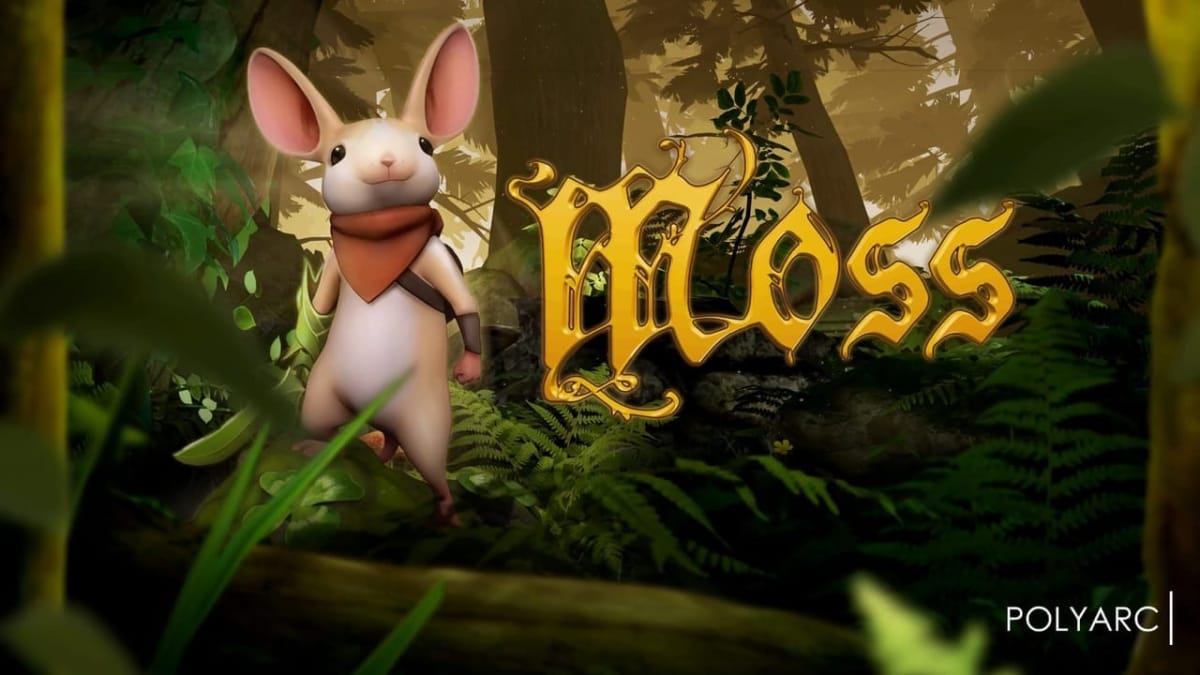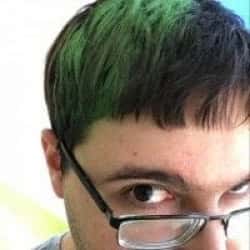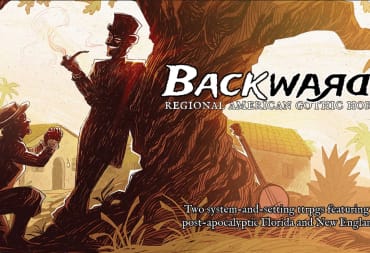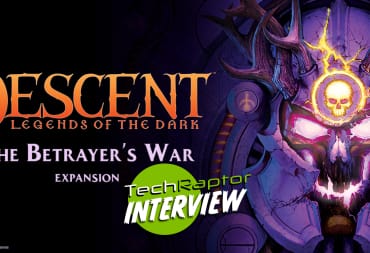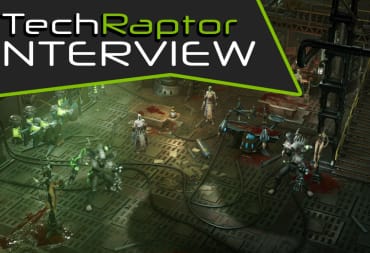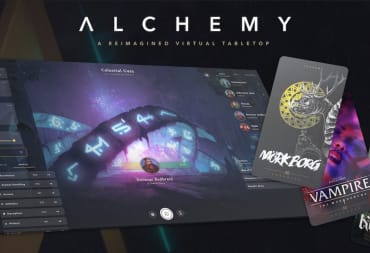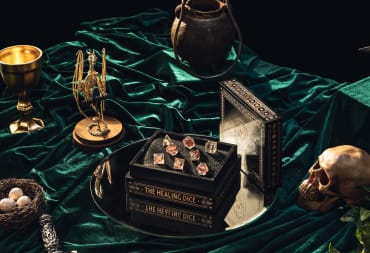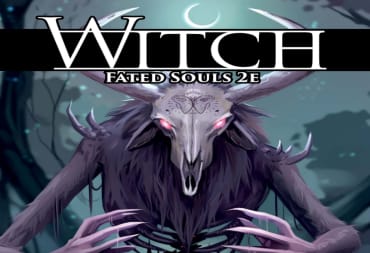I keep it no secret that Moss was one of my most anticipated games of 2018. After it came out in February, I gave it a look and found it to be just as good as I hoped. However, now that I've finished the game, I've got a sad mouse-shaped hole in my heart. Thankfully, I got a chance to talk to Richard Lico, the animation director for Moss. Having worked in the game industry as an animator for 18 years, Lico has worked on games such as Halo ODST and Reach, Destiny 1 & 2, both Condemned games, and more. Lico left Bungie with his friends to create Polyarc, and was nice enough to have a conversation with me about the creation of Moss, animating in VR, and tweets that explode in popularity.
TechRaptor: So for those that aren’t aware of Moss, or are still on the fence on buying Moss, can you just quickly give the rundown on Moss and why you should get it?
Richard Lico: Well Moss is a shared adventure. You play the role of the Reader and you join Quill, a little mouse, on a shared adventure. It’s unique to VR in which case we designed it specifically for VR as opposed to porting a game that currently existed to a VR platform. So it takes advantage of all the interesting technology and all the interesting things you can do in VR, such as connecting with a character such as Quill. We spent a lot of time crafting a partner, a friend, for the player. So it’s more relationship building on top of a game itself. So it tries to evolve the medium a little bit more.
TR: Awesome. Alright, so, in February Moss came out. How does it feel that finally the game is out, that it’s in people’s hands?
Richard: Oh it feels great. [Laughter] It’s been a lot of fun making the game. I’ve actually had more fun making Moss than any other project I’ve worked on, and we hope it shows in the final product and we hope that players can see all the love that we’ve put into it, because this was definitely a passion project for all of us.
TR: If it helps I loved Moss, just as an aside.
Richard: Yay! Thanks.
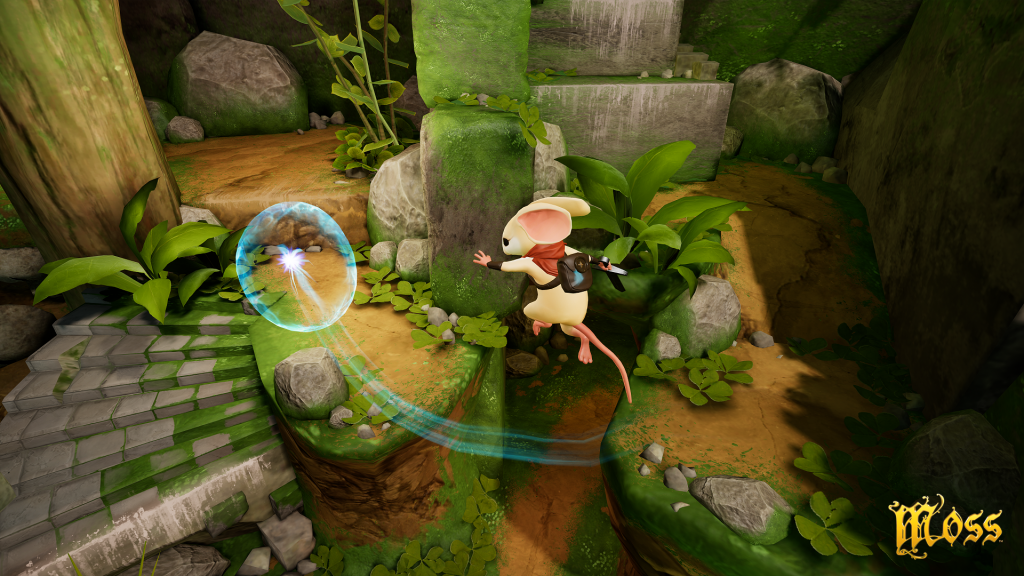
TR: One thing, when I was playing Moss, I really noticed Quill is super expressive. You can give her high fives, she does little cheers whenever you solve a puzzle, win a fight, whatever. What went into making all those expressions and everything?
Richard: Well cool, I’m glad you notice that stuff. That’s awesome. It came from a need to make her feel real. So whenever you play-- you know, when you play traditional games your character just responds to your controller, and they, you know, they’ll interact with each other in story but in gameplay it’s pretty much just what that character does is based on your button inputs, right? So we wanted Quill to be your friend, and if she just reacted to button inputs then she wouldn’t feel real, she’d just feel like a standard game character. So to break her out of that mold, to give her a personality, we had to give her the ability to think through things, to have an opinion, to express said opinion to you. So she’ll often break out of gameplay and do those little gestures to you and find ways to interact with you.
But it’s also VR, because VR adds that extra depth, that extra sense of immersion, that allows you to interact with Quill in more natural and meaningful ways. So being able to high five her is not something you can do on a standard console game. Well, non-VR I mean. You know, waving to her is not something you can do in a non-VR game, so we wanted to build on that and find ways to break that fourth wall and make you feel like you’re there with her. Plus it was also a way to convey gameplay, because we don’t have a UI. So If you’re stuck on a puzzle, Quill can help you solve that puzzle, and not only did that help you through the puzzle when you’re stuck, but it implied she could think, it implied she’s aware of your presence and she’s kind of figured out the puzzle but she doesn’t speak your language and she’s trying to communicate that in her own way, and it just adds to her sense of realism and her believability.
TR: Yeah I did notice when solving puzzles she did little dances, pointed at things, made explosion noises.
Richard: [Laughter]. Yeah that was one of our favorite ones, the little Mega Man reference there.
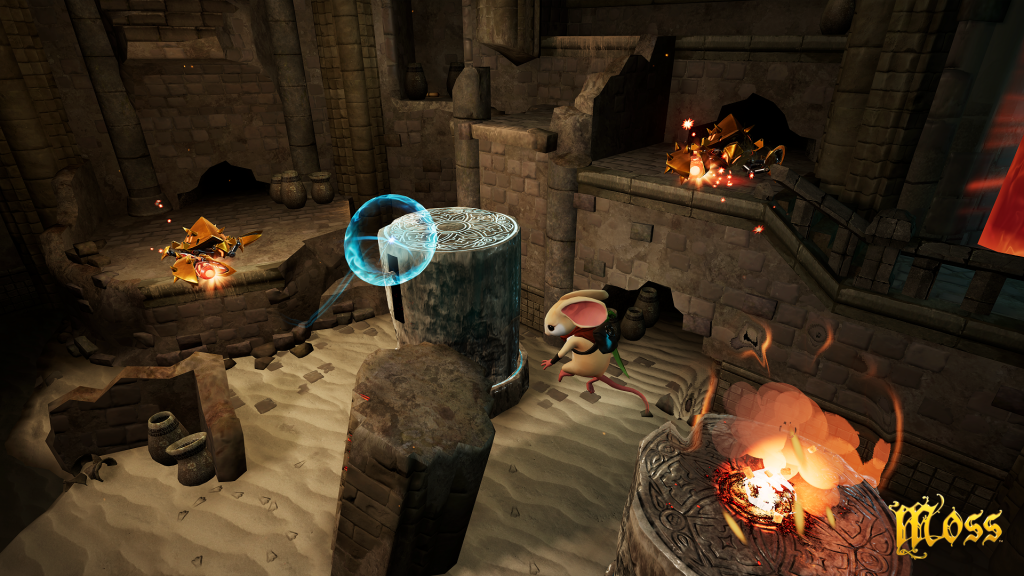
TR: So one thing I noticed also is that many of Quill’s attack animations, I wouldn’t say were powerful, but they feel like you could almost hear her screaming “Maximum Effort” while doing them. One that especially stuck out to me is the jump attack, which I still think is hilarious. How did you go about designing those?
Richard: [Laughter]. I’m so glad you like that stuff. Well, she’s super small. I got to thinking, how would a character of that size make an impact in her world? Well she’d do it by putting in the most effort she possibly could to affect that world. Plus she’s super young. She’s essentially like our version of a teenager in her mouse years. So she’d also act with that reckless abandon, like she’s not going to die. She’s not aware of her own mortality. So I came up with a set of poses for the attacks that just made her seem, just, insane. Like just throwing her entire body at the attack as opposed to just using the sword. From there I just filled out the rest of the animations and it all just started coming together. Then of course, just trying to get the flow of it right and make it feel correct.
TR: Another thing with Quill is she sometimes speaks to the player in Sign Language. I don’t know if it’s American Sign Language or a different kind, but I did notice she was using sign language. How did that one come about?
Richard: That was essentially the same way the rest of her gestures came about. We were watching a play test one afternoon and I was noticing that she was just doing basic pantomimes and the player was really confused like “What are you trying to tell me girl? What’s the solution here?” They didn’t understand her. So I figure “Well, maybe Sign Language might be a way where more people would get it.” Because Sign Language was created to help people who can’t communicate properly, that, you know, are deaf, they can’t speak properly because they’ve been deaf so long they don’t know how to form the words sometimes, it just aids in that communication. So it was invented to make it obvious to a person that doesn’t know Sign Language find out what they’re saying. It can be complicated sometimes and you don’t always understand, but there’s that base level. Like “thank you”, when somebody says “thank you” in Sign Language, even if you don’t know Sign Language, you know they’re saying “thank you”. So I wanted to take that form of communication and make it easier for the player to understand her. But it was also a nice nod to the deaf community, to really support them, because they’re certainly under served in this industry. Then, thirdly, it also makes her feel like she’s thinking. So it was just another way to bring her to life.
TR: Yeah I remember seeing the--, I don’t remember if it was you who tweeted or someone from Polyarc…
Richard: Yeah that was me.
TR: That was you? Ok. Because I remember seeing the tweet of Quill doing Sign Language, and I was— I think that’s what really sold me on the game if I’m being honest, I thought that was super impressive.
Richard: Wow, cool. You hear that Lincoln? [In the background Sales, Publishing, and Marketing Director Lincoln Davis says “Mm-hm.” Both Richard and Lincoln laugh.] We got lucky with that Tweet, I honestly didn’t expect it to go anywhere. I just figured I’d get some feedback on an animation, I had no idea.
TR: Well, it helped, if that helps!
Richard: Cool [In the background Lincoln says “Yeah!”]
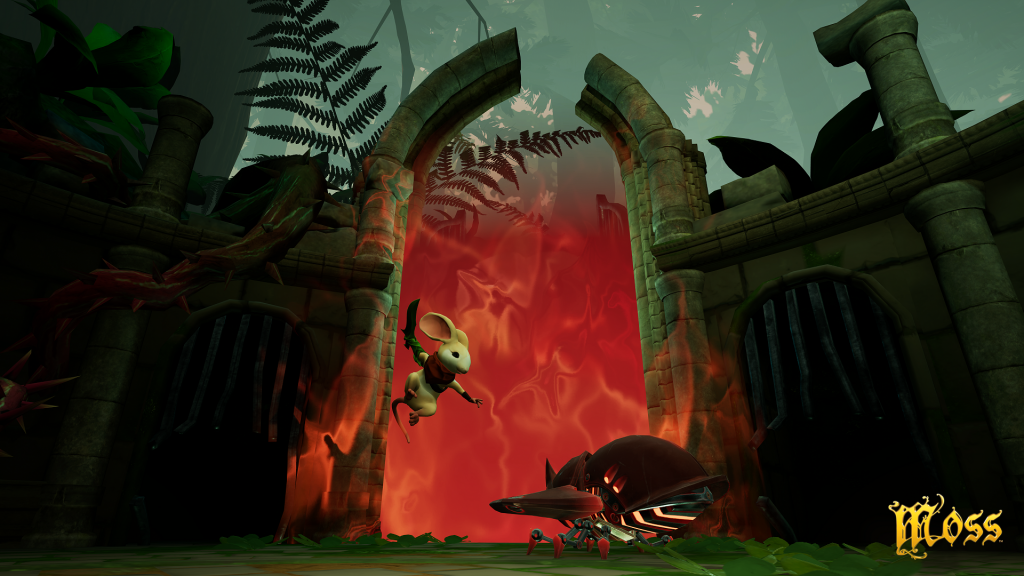
TR: Alright, I’ve talked about Quill a lot. How about the rest of the world? There’s the robotic enemies, there’s just the general environment, what was the basic principle for animating that stuff?
Richard: Our Art Director, Chris Alderson, he came up with the designs for those characters. So he kind of set the initial tone for, you know the general-- not to dark, not too lighthearted, some nice in-between where the characters are fun looking and fun to fight and do fun things, but also feel a bit intimidating. Especially the snake. Going off of that cue, I did a bunch of test animations with some early prototypes for those characters that had a sense of whimsy to them, but also had, you know, a decent amount of violence to their attacks and when they got killed or got hit you’d feel it. It would feel impactful. We just kept building from there. Quill was kind of like the stepping stone for that where she was this pretty optimistic, pretty upbeat, pretty jovial character, and how do we balance that? So the easier enemies are more lighthearted, more whimsical, and the harder enemies, the further you get into the game, the darker they start getting in tone to increase that contrast with who Quill is.
When you actually look at the snake, the inspiration for that— We actually started with real snake animations. I actually animated it to feel like a real snake, and we’ve got a guy in the office who’s afraid of snakes and it totally freaked him out. So I had to back off of that approach. We turned it more into an armored dragon, to get people who are afraid of snakes to not be afraid of it, but we still made it feel pretty dark because it’s that opposite end of the spectrum from Quill. We tried to make it feel-- I wanted to give it arcs and I wanted to give it a flow to it that would feel interesting and draw you in, but also make the attacks feel visceral and make it when you finally finish the snake make it feel impactful, make Quill feel like a hero. Really play with the player’s emotions through all of those animations.
TR: The snake, since you brought that up, I thought it was rather impressive near the end of the game. One thing that stood out was that there was the whole final fight between Quill and the giant snake, who’s, I’m sorry, name I’m kind of forgetting right now…
Richard: Sarffog.
TR: Thank you. Quill and Sarffog. How did that whole final fight sequence come about?
Richard: That was a lot of trial and error. That was Danny Bulla [Bulla is one of Moss’ Game Designers] and I were working on, and we knew we wanted to do the snake, we had no idea what we were going to do with him in an encounter with the snake, because of the scale difference between Quill and the snake. I mean the snake has a clear advantage in that situation. So what we wanted to do was play with, more of like a chase scene, where it wasn’t a direct conflict where you were using your sword to hack at the body of a snake, because the snake would just… one gulp and Quill is gone. So we had Quill running through the different environments, and we have the snake trying to corner her and catch her in these environments. But we wanted to make it like the snake was playing with Quill at first. The snake comes up and can obviously just instantly just chew her down, but the snake’s like “Alright, I got’cha, you’re screwed. I’m just gonna watch you squirm a bit.” That, over the course of, I think, seven rooms where we fight this snake, over that time the snake’s attitude changes to be more of “I’m just gonna kill you now.”
Trying to figure out the gameplay was like “Okay, well, we need to be able to damage the snake, how do we do that? Well Quill can’t do it, she’s not big enough, that sword is not going to do any damage. Alright let's put some ballistias there.” Then, okay, well what does that mean to the world and why are they there? Well there was this big war that happened in the past and that’s why they’re there, in the ruined castle. It makes sense that the ballista was left unfired, because the war ended before they got a chance to fire it off, right? Then we start playing with moments like that. The final encounter was more of like a Hollywood moment. Where I really just wanted to make it a reward for the player. As opposed to super difficult I want it to be more like your payoff. So have that big flashy moment where she zip lines across, and then leaps on the head and stabs down through a little crack in the armor. Which we had to add very late in the game because she was stabbing through the clear armor and it didn’t make sense. Then, you know, go into slow motion. That actually happened I think, like what, two weeks before we shipped? We added the slow motion, I think it was the last thing I did before we shipped. It was this cool moment where everyone was just “it doesn’t feel impactful enough” and then we threw in the slow motion, which was totally done just by scaling down the animation, and then everyone was like “yeah! That’s it!” and it just all came together. It really was just throwing darts at a dart board and seeing what stuck.
TR: Oh jeez, two weeks before you shipped?
Richard: Yeah it was … we came in hot.
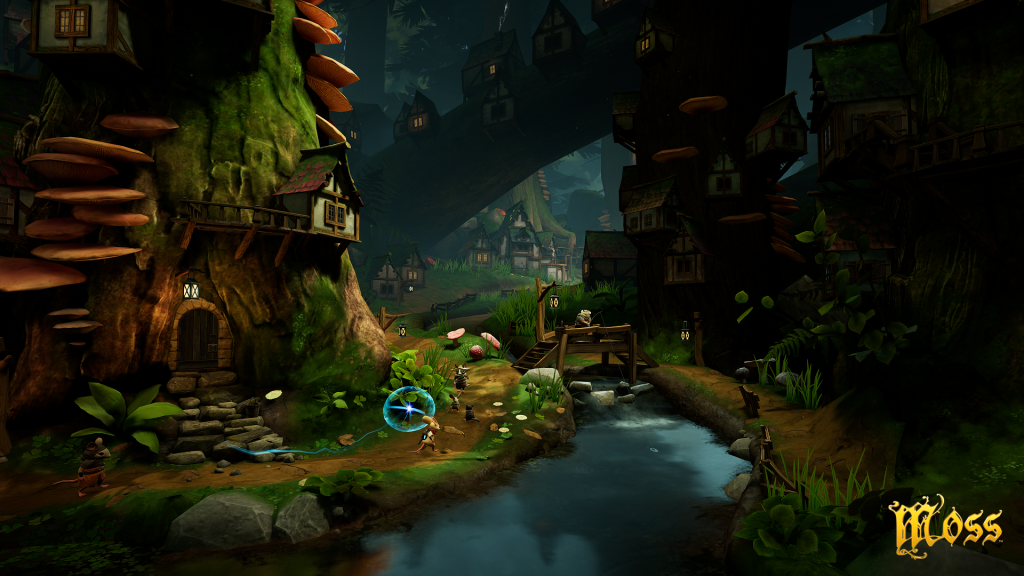
TR: That’s impressive. Alright, so, I did a little bit of snooping because that’s half my job. Before Moss you worked on Duke Nukem: Manhattan Project, Star Wars: Jedi Knight - Jedi Academy, both the Condemned games, Halo ODST and Reach, both Destiny games … What’s the difference between working on, say, those games and Moss, which is a VR game?
Richard: I think every game is a bit different, but Moss being the biggest difference because of VR. I think that the challenge with a regular console game is you just try to make something read on the TV screen and feel good when you’re pressing buttons, right? You make sure your characters react properly and the enemies react to your character properly. It’s all pretty standard in all console games, like you press a button you want it to feel good when that character moves or jumps or attacks or whatever. That applies to VR as well, Quill still had to feel good swinging the sword and she had to feel good jumping so that part was similar but from there it was bringing her to life in a way that was more meaningful than traditional console games, and I touched on this earlier about bringing her to life, the making her feel like a real living breathing partner to you, a friend, and not just some game character avatar like I’ve worked on in the past. If you look at Destiny, specifically Destiny 2 where they took the player’s voice away so the player no longer speaks, it’s because their concept is they want you to fill the personality of the player with your own personality. That means that your Destiny 2 Guardian is you. So there’s really no specific personality animations you can do for a Guardian because it might betray who the player is with the controller in their hands. So Quill is the total opposite of that. I had to define her as a character because even though you’re controlling her you’re also a character in the world. So it was really challenging making that mental shift away from just gameplay representational content to really crafting a living creature.
TR: I assume there’s also a difference between, uh, camerawork’s probably the biggest difference because with VR you can look anywhere, compared to a game that’s not VR once a cutscene starts you got the player’s attention to whatever you want it to be.
Richard: Yeah it’s— I mean it’s actually not as different as you’d think. My background I’ve worked on some cinematic stuff but it’s not really where I’ve spent a lot of my time, it's just been side things here and there. Most of my career is spent doing gameplay. If you actually look at the player camera in Destiny, you can run around your friend who you’re playing with and see them from any angle, and in VR you can look around Quill and see her from any angle. So a lot of the lessons I’ve learned from the past kind of still apply for VR. About the only thing different with VR is you could look, you know, move your head down, get really close to Quill and even penetrate into her geometry if you try hard. It was challenging to try and get her to read from really close and also really far, because you can lean your head in so close. Then the top-down perspective is something most games don’t do unless you’re DOTA or League of Legends or something like that. So trying to craft animations for those, but it’s not really drastically difficult because it really comes down to clear silhouette, clear actions, make sure you hold key poses for five frames at least so the player’s eye can catch it and read it, like all the stuff you learn doing console games does apply here. It actually just makes it so all the lessons I’ve learned I just apply it, and it all just kind of works.
TR: Alright. I got one last question and it’s probably the one you can’t answer, but I have to ask anyway because I’m curious. What’s next?
Richard:What’s next, huh? Well…
TR: Yeah, when’s Moss 2 please.
Richard: [Laughter.] I’m sure Lincoln will probably post stuff or whatever whenever we have something to announce, we’ll announce it. You know we’re a studio and we work hard, so you know we’re working on something.
TR: You’re killing me here.
[Both Richard and Lincoln laugh.]
TR: Alright, well, thanks a ton for taking the time to speak with me and for answering the questions. I thought it was super interesting and I’m sure other people will too. Good luck with whatever, well I’m hoping it’s Moss 2, but with whatever is next.
We'd like to tank Richard, and Lincoln, for their time in speaking with us.
Have a tip, or want to point out something we missed? Leave a Comment or e-mail us at tips@techraptor.net
